Identification and Expression Analysis of Chalcone Synthase Gene Family in Tartary Buckwheat
Abstract
1. Introduction
2. Materials and Methods
2.1. Plant Materials and Sample Collection
2.2. Genome−Wide Identification of the CHS Family Members in Tartary Buckwheat
2.3. Chromosomal Location and Gene Duplication Analysis of FtCHS Genes
2.4. Phylogenetic Analysis of FtCHS Genes
2.5. Gene Structures, Conserved Motifs, and Sequence Features of FtCHS Genes
2.6. Promoter Element Analysis of FtCHS Genes
2.7. Tissue Expression Analysis of FtCHS Genes
3. Results
3.1. Identification of the CHS Gene Family Members in Tartary Buckwheat
3.2. Chromosomal Location and Gene Duplication
3.3. Phylogenetic Analysis and Classification of FtCHS Genes
3.4. Gene Structures of FtCHS Genes
3.5. Conserved Motifs and Sequence Features of FtCHS Proteins
3.6. Analysis of Promoter Cis-Regulatory Elements in FtCHS Genes
3.7. Tissue Expression Patterns of FtCHS Genes
4. Discussion
5. Conclusions
Supplementary Materials
Author Contributions
Funding
Institutional Review Board Statement
Informed Consent Statement
Data Availability Statement
Conflicts of Interest
References
- Shen, N.; Wang, T.; Gan, Q.; Liu, S.; Wang, L.; Jin, B. Plant flavonoids: Classification, distribution, biosynthesis, and antioxidant activity. Food Chem. 2022, 383, 132531. [Google Scholar]
- Chen, S.; Wang, X.; Cheng, Y.; Gao, H.; Chen, X. A review of classification, biosynthesis, biological activities and potential applications of flavonoids. Molecules 2023, 28, 4982. [Google Scholar] [CrossRef] [PubMed]
- Hussain, A.; Azam, S.; Maqsood, R.; Anwar, R.; Akash, M.S.H.; Hussain, H.; Wang, D.; Imran, M.; Kotwica-Mojzych, K.; Khan, S.; et al. Chemistry, biosynthesis, and theranostics of antioxidant flavonoids and polyphenolics of genus Rhododendron: An overview. N-S Arch. Pharmacol. 2025, 398, 1171–1214. [Google Scholar]
- Vicente, O.; Boscaiu, M. Flavonoids: Antioxidant compounds for plant defence and for a healthy human diet. Not. Bot. Horti Agrobot. Cluj. 2018, 46, 14–21. [Google Scholar] [CrossRef]
- Zhuang, W.B.; Li, Y.H.; Shu, X.C.; Pu, Y.T.; Wang, X.J.; Wang, T.; Wang, Z. The classification, molecular structure and biological biosynthesis of flavonoids, and their roles in biotic and abiotic stresses. Molecules 2023, 28, 3599. [Google Scholar] [CrossRef]
- Liu, W.; Feng, Y.; Yu, S.; Fan, Z.; Li, X.; Li, J.; Yin, H. The flavonoid biosynthesis network in plants. Int. J. Mol. Sci. 2021, 22, 12824. [Google Scholar] [CrossRef]
- Guo, D.; Wang, H.; Zhang, S.; Lan, T. The type III polyketide synthase supergene family in plants: Complex evolutionary history and functional divergence. Plant J. 2022, 112, 414–428. [Google Scholar] [CrossRef] [PubMed]
- Kong, X.; Khan, A.; Li, Z.; You, J.; Munsif, F.; Kang, H.; Zhou, R. Identification of chalcone synthase genes and their expression patterns reveal pollen abortion in cotton. Saudi J. Biol. Sci. 2020, 27, 3691–3699. [Google Scholar] [CrossRef] [PubMed]
- Zhu, L.; Ding, Y.; Wang, S.; Wang, Z.; Dai, L. Genome-wide identification, characterization, and expression analysis of CHS gene family members in Chrysanthemum nankingense. Genes 2022, 13, 2145. [Google Scholar] [CrossRef]
- Xie, Z.; Yang, L.; Fan, M.; Xuan, S.; Jia, X.; Zhang, Z.; Li, N.; Liu, M.; Zhao, J.; Li, J. Genome-wide identification, characterization and expression analysis of the chalcone synthase gene family in Chinese cabbage. BMC Genom. 2025, 26, 168. [Google Scholar] [CrossRef]
- Zhang, Z.; Qu, P.; Hao, S.; Li, R.; Zhang, Y.; Zhao, Q.; Wen, P.; Cheng, C. Characterization and functional analysis of chalcone synthase genes in highbush blueberry (Vaccinium corymbosum). Int. J. Mol. Sci. 2023, 24, 13882. [Google Scholar] [CrossRef] [PubMed]
- Imaizumi, R.; Mameda, R.; Takeshita, K.; Kubo, H.; Sakai, N.; Nakata, S.; Takahashi, S.; Kataoka, K.; Yamamoto, M.; Nakayama, T.; et al. Crystal structure of chalcone synthase, a key enzyme for isoflavonoid biosynthesis in soybean. Proteins Struct. Funct. Bioinform. 2021, 89, 126–131. [Google Scholar] [CrossRef] [PubMed]
- Samappito, S.; Page, J.; Schmidt, J.; De-Eknamkul, W.; Kutchan, T.M. Molecular characterization of root-specific chalcone synthases from Cassia alata. Planta 2002, 216, 64–71. [Google Scholar] [CrossRef]
- Ito, M.; Ichinose, Y.; Kato, H.; Shiraishi, T.; Yamada, T. Molecular evolution and functional relevance of the chalcone synthase genes of pea. Mol. Gen. Genet. 1997, 255, 28–37. [Google Scholar] [CrossRef]
- Nityagovsky, N.N.; Kiselev, K.V.; Suprun, A.R.; Dubrovina, A.S. Exogenous dsRNA induces RNA interference of a chalcone synthase gene in Arabidopsis thaliana. Int. J. Mol. Sci. 2022, 23, 5325. [Google Scholar] [CrossRef] [PubMed]
- Park, H.L.; Yoo, Y.; Bhoo, S.H.; Lee, T.H.; Lee, S.W.; Cho, M.H. Two chalcone synthase isozymes participate redundantly in UV-induced sakuranetin synthesis in rice. Int. J. Mol. Sci. 2020, 21, 3777. [Google Scholar] [CrossRef]
- Dong, H.; Li, H.; Xue, Y.; Su, S.; Li, S.; Shan, X.; Liu, H.; Jiang, N.; Wu, X.; Zhang, Z.; et al. E183K mutation in chalcone synthase C2 causes protein aggregation and maize colorless. Front. Plant Sci. 2021, 12, 679654. [Google Scholar] [CrossRef] [PubMed]
- Colanero, S.; Perata, P.; Gonzali, S. What’s behind purple tomatoes? Insight into the mechanisms of anthocyanin synthesis in tomato fruits. Plant Physiol. 2020, 182, 1841–1853. [Google Scholar] [CrossRef]
- Yu, Y.; Li, Z.; Wu, Y.; Xie, G.; Guo, Y.; Yang, Z. QTL mapping and identification of candidate genes for anthocyanidin accumulation in Salvia miltiorrhiza flowers. J. Hered. 2025, esaf004. [Google Scholar] [CrossRef]
- Huang, J.; Zhao, X.; Zhang, Y.; Chen, Y.; Zhang, X.; Yi, Y.; Ju, Z.; Sun, W. Chalcone-synthase-encoding RdCHS1 is involved in flavonoid biosynthesis in Rhododendron delavayi. Molecules 2024, 29, 1822. [Google Scholar] [CrossRef]
- Ma, M.; Zhong, M.; Zhang, Q.; Zhao, W.; Wang, M.; Luo, C. Phylogenetic implications and functional disparity in the chalcone synthase gene family of common sea grass Zostera marina. Front. Mar. Sci. 2021, 8, 760902. [Google Scholar] [CrossRef]
- Zou, L.; Wu, D.; Ren, G.; Hu, Y.; Peng, L.; Zhao, J.; Garcia-Perez, P.; Carpena, M.; Prieto, M.A.; Cao, H.; et al. Bioactive compounds, health benefits, and industrial applications of Tartary buckwheat (Fagopyrum tataricum). Crit. Rev. Food Sci. Nutr. 2023, 63, 657–673. [Google Scholar] [CrossRef]
- Xu, H.; Jiang, Z.; Lin, Z.; Yu, Q.; Song, R.; Wang, B. FtUGT79A15 is responsible for rutinosylation in flavonoid diglycoside biosynthesis in Fagopyrum tataricum. Plant Physiol. Biochem. 2022, 181, 33–41. [Google Scholar] [CrossRef]
- Wang, L.; Deng, R.; Bai, Y.; Wu, H.; Li, C.; Wu, Q.; Zhao, H. Tartary buckwheat R2R3-MYB gene FtMYB3 negatively regulates anthocyanin and proanthocyanin biosynthesis. Int. J. Mol. Sci. 2022, 23, 2775. [Google Scholar] [CrossRef] [PubMed]
- Yao, P.; Huang, Y.; Dong, Q.; Wan, M.; Wang, A.; Chen, Y.; Li, C.; Wu, Q.; Chen, H.; Zhao, H. FtMYB6, a light-induced SG7 R2R3-MYB transcription factor, promotes flavonol biosynthesis in tartary buckwheat (Fagopyrum tataricum). J. Agric. Food Chem. 2020, 68, 13685–13696. [Google Scholar] [CrossRef] [PubMed]
- Huang, Y.; Wu, Q.; Wang, S.; Shi, J.; Dong, Q.; Yao, P.; Shi, G.; Xu, S.; Deng, R.; Li, C.; et al. FtMYB8 from Tartary buckwheat inhibits both anthocyanin/Proanthocyanidin accumulation and marginal Trichome initiation. BMC Plant Biol. 2019, 19, 263. [Google Scholar]
- Mi, Y.; Li, Y.; Qian, G.; Vanhaelewyn, L.; Meng, X.; Liu, T.; Yang, W.; Shi, Y.; Ma, P.; Tul-Wahab, A.; et al. A transcriptional complex of FtMYB102 and FtbHLH4 coordinately regulates the accumulation of rutin in Fagopyrum tataricum. Plant Physiol. Biochem. 2023, 194, 696–707. [Google Scholar] [CrossRef]
- Liu, S.; Wang, J.; Liu, Z.; Yang, Y.; Li, X. FtbZIP85 is involved in the accumulation of proanthocyanidin by regulating the transcription of FtDFR in tartary buckwheat. Curr. Issues Mol. Biol. 2023, 45, 3375–3390. [Google Scholar] [CrossRef]
- Ding, M.; Zhang, K.; He, Y.; Zuo, Q.; Zhao, H.; He, M.; Georgiev, M.I.; Park, S.U.; Zhou, M. FtBPM3 modulates the orchestration of FtMYB11-mediated flavonoids biosynthesis in Tartary buckwheat. Plant Biotechnol. J. 2021, 19, 1285–1287. [Google Scholar] [CrossRef]
- Ding, M.; He, Y.; Zhang, K.; Li, J.; Shi, Y.; Zhao, M.; Meng, Y.; Georgiev, M.I.; Zhou, M. JA-induced FtBPM3 accumulation promotes FtERF-EAR3 degradation and rutin biosynthesis in Tartary buckwheat. Plant J. 2022, 111, 323–334. [Google Scholar] [CrossRef]
- Deng, J.; Wang, L.; Zhang, L.; Yang, C.; Huang, J.; Zhu, L.; Chen, Q.; Meng, Z.; Cai, F.; Shi, T. Tartary buckwheat (Fagopyrum tataricum) FtTT8 inhibits anthocyanin biosynthesis and promotes proanthocyanidin biosynthesis. Int. J. Mol. Sci. 2023, 24, 17368. [Google Scholar] [CrossRef]
- Yao, H.; Li, C.; Zhao, H.; Zhao, J.; Chen, H.; Bu, T.; Anhu, W.; Wu, Q. Deep sequencing of the transcriptome reveals distinct flavonoid metabolism features of black tartary buckwheat (Fagopyrum tataricum Garetn.). Prog. Biophys. Mol. Biol. 2017, 124, 49–60. [Google Scholar] [CrossRef] [PubMed]
- Yao, P.; Zhao, H.; Luo, X.; Gao, F.; Yao, H.; Li, C.; Chen, H.; Wu, Q. Chalcone synthase homologous genes cloning and expression pattern in flowering Fagopyrum tataricum Gaertn. Russ. J. Plant Phys. 2016, 63, 790–799. [Google Scholar] [CrossRef]
- Zhang, L.; Li, X.; Ma, B.; Gao, Q.; Du, H.; Han, Y.; Li, Y.; Cao, Y.; Qi, M.; Zhu, Y.; et al. The tartary buckwheat genome provides insights into rutin biosynthesis and abiotic stress tolerance. Mol. Plant 2017, 10, 1224–1237. [Google Scholar] [CrossRef]
- Potter, S.C.; Luciani, A.; Eddy, S.R.; Park, Y.; Lopez, R.; Finn, R.D. HMMER web server: 2018 update. Nucleic Acids Res. 2018, 46, W200–W204. [Google Scholar] [CrossRef] [PubMed]
- Blum, M.; Andreeva, A.; Florentino, L.C.; Chuguransky, S.R.; Grego, T.; Hobbs, E.; Pinto, B.L.; Orr, A.; Paysan-Lafosse, T.; Ponamareva, I.; et al. InterPro: The protein sequence classification resource in 2025. Nucleic Acids Res. 2025, 53, D444–D456. [Google Scholar] [CrossRef]
- Wang, J.; Chitsaz, F.; Derbyshire, M.K.; Gonzales, N.R.; Gwadz, M.; Lu, S.; Marchler, G.H.; Song, J.S.; Thanki, N.; Yamashita, R.A.; et al. The conserved domain database in 2023. Nucleic Acids Res. 2023, 51, D384–D388. [Google Scholar] [CrossRef]
- Gasteiger, E.; Hoogland, C.; Gattiker, A.; Duvaud, S.; Wilkins, M.R.; Appel, R.D.; Bairoch, A. Protein identification and analysis tools on the Expasy server. In The Proteomics Protocols Handbook; Walker, J.M., Ed.; Humana Press: Hatfield, UK, 2005; pp. 571–607. [Google Scholar]
- Chou, K.C.; Shen, H.B. Cell-PLoc: A package of Web servers for predicting subcellular localization of proteins in various organisms. Nat. Protoc. 2008, 3, 153–162. [Google Scholar] [CrossRef]
- Chen, C.; Wu, Y.; Li, J.; Wang, X.; Zeng, Z.; Xu, J.; Liu, Y.; Feng, J.; Chen, H.; He, Y.; et al. TBtools-II: A “one for all, all for one” bioinformatics platform for biological big-data mining. Mol. Plant 2023, 16, 1733–1742. [Google Scholar] [CrossRef]
- Tamura, K.; Stecher, G.; Kumar, S. MEGA11: Molecular evolutionary genetics analysis version 11. Mol. Biol. Evol. 2021, 38, 3022–3027. [Google Scholar] [CrossRef]
- Bailey, T.L.; Johnson, J.; Grant, C.E.; Noble, W.S. The MEME Suite. Nucleic Acids Res. 2015, 43, W39–W49. [Google Scholar] [CrossRef]
- Ferrer, J.L.; Jez, J.M.; Bowman, M.E.; Dixon, R.A.; Noel, J.P. Structure of chalcone synthase and the molecular basis of plant polyketide biosynthesis. Nat. Struct. Biol. 1999, 6, 775–784. [Google Scholar]
- Choudhary, P.; Feng, Z.; Berrisford, J.; Chao, H.; Ikegawa, Y.; Peisach, E.; Piehl, D.W.; Smith, J.; Tanweer, A.; Varadi, M.; et al. PDB NextGen Archive: Centralizing access to integrated annotations and enriched structural information by the Worldwide Protein Data Bank. Database 2024, 2024, baae041. [Google Scholar] [CrossRef]
- Robert, X.; Gouet, P. Deciphering key features in protein structures with the new ENDscript server. Nucleic Acids Res. 2014, 42, W320–W324. [Google Scholar] [CrossRef] [PubMed]
- Lescot, M.; Déhais, P.; Thijs, G.; Marchal, K.; Moreau, Y.; Van de Peer, Y.; Rouzé, P.; Rombauts, S. PlantCARE, a database of plant cis-acting regulatory elements and a portal to tools for in silico analysis of promoter sequences. Nucleic Acids Res. 2002, 30, 325–327. [Google Scholar] [CrossRef] [PubMed]
- Pfaffl, M.W. A new mathematical model for relative quantification in real-time RT-PCR. Nucleic Acids Res. 2001, 29, e45. [Google Scholar] [CrossRef] [PubMed]
- Das Laha, S.; Dutta, S.; Schäffner, A.R.; Das, M. Gene duplication and stress genomics in Brassicas: Current understanding and future prospects. J. Plant. Physiol. 2020, 255, 153293. [Google Scholar] [CrossRef]
- Atanassov, I.; Russinova, E.; Antonov, L.; Atanassov, A. Expression of an anther-specific chalcone synthase-like gene is correlated with uninucleate microspore development in Nicotiana sylvestris. Plant Mol. Biol. 1998, 38, 1169–1178. [Google Scholar] [CrossRef]
- Jiang, C.; Schommer, C.K.; Kim, S.Y.; Suh, D.Y. Cloning and characterization of chalcone synthase from the moss, Physcomitrella patens. Phytochemistry 2006, 67, 2531–2540. [Google Scholar] [CrossRef]
- Pandith, S.A.; Ramazan, S.; Khan, M.I.; Reshi, Z.A.; Shah, M.A. Chalcone synthases (CHSs): The symbolic type III polyketide synthases. Planta 2019, 251, 15. [Google Scholar] [CrossRef]
- Comelli, R.N.; Gonzalez, D.H. Identification of regulatory elements involved in expression and induction by sucrose and UV-B light of the Arabidopsis thaliana COX5b-2 gene, encoding an isoform of cytochrome c oxidase subunit 5b. Physiol. Plant 2009, 137, 213–224. [Google Scholar] [CrossRef]
- Hemleben, V.; Dressel, A.; Epping, B.; Lukacin, R.; Martens, S.; Austin, M. Characterization and structural features of a chalcone synthase mutation in a white-flowering line of Matthiola incana R. Br. (Brassicaceae). Plant Mol. Biol. 2004, 55, 455–465. [Google Scholar] [CrossRef]
- Hou, Q.; Li, S.; Shang, C.; Wen, Z.; Cai, X.; Hong, Y.; Qiao, G. Genome-wide characterization of chalcone synthase genes in sweet cherry and functional characterization of CpCHS1 under drought stress. Front. Plant Sci. 2022, 13, 989959. [Google Scholar] [CrossRef] [PubMed]
- Burbulis, I.E.; Iacobucci, M.; Shirley, B.W. A null mutation in the first enzyme of flavonoid biosynthesis does not affect male fertility in Arabidopsis. Plant Cell 1996, 8, 1013–1025. [Google Scholar] [PubMed]
- Liu, Y.; Bai, J.; Yuan, S.; Gao, S.; Liu, Z.; Li, Y.; Zhang, F.; Zhao, C.; Zhang, L. Characterization and expression analysis of chalcone synthase gene family members suggested their roles in the male sterility of a wheat temperature-sensitive genic male sterile (TGMS) line. Gene 2023, 888, 147740. [Google Scholar] [CrossRef]
- Yao, Y.; Sun, L.; Wu, W.; Wang, S.; Xiao, X.; Hu, M.; Li, C.; Zhao, H.; Chen, H.; Wu, Q. Genome-wide investigation of major enzyme-encoding genes in the flavonoid metabolic pathway in tartary buckwheat (Fagopyrum tataricum). J. Mol. Evol. 2021, 89, 269–286. [Google Scholar] [CrossRef]
- Wang, Y.; Chen, F.; Ma, Y.; Zhang, T.; Sun, P.; Lan, M.; Li, F.; Fang, W. An ancient whole-genome duplication event and its contribution to flavor compounds in the tea plant (Camellia sinensis). Hortic. Res. 2021, 8, 176. [Google Scholar] [CrossRef] [PubMed]
- Juretic, N.; Hoen, D.R.; Huynh, M.L.; Harrison, P.M.; Bureau, T.E. The evolutionary fate of MULE-mediated duplications of host gene fragments in rice. Genome Res. 2005, 15, 1292–1297. [Google Scholar] [CrossRef]
- Faraji, S.; Filiz, E.; Kazemitabar, S.K.; Vannozzi, A.; Palumbo, F.; Barcaccia, G.; Heidari, P. The AP2/ERF gene family in Triticum durum: Genome-wide identification and expression analysis under drought and salinity stresses. Genes 2020, 11, 1464. [Google Scholar] [CrossRef]
- Oakley, T.H.; Ostman, B.; Wilson, A.C. Repression and loss of gene expression outpaces activation and gain in recently duplicated fly genes. Proc. Natl. Acad. Sci. USA 2006, 103, 11637–11641. [Google Scholar] [CrossRef]
- Gu, X. Statistical framework for phylogenomic analysis of gene family expression profiles. Genetics 2004, 167, 531–542. [Google Scholar] [CrossRef]

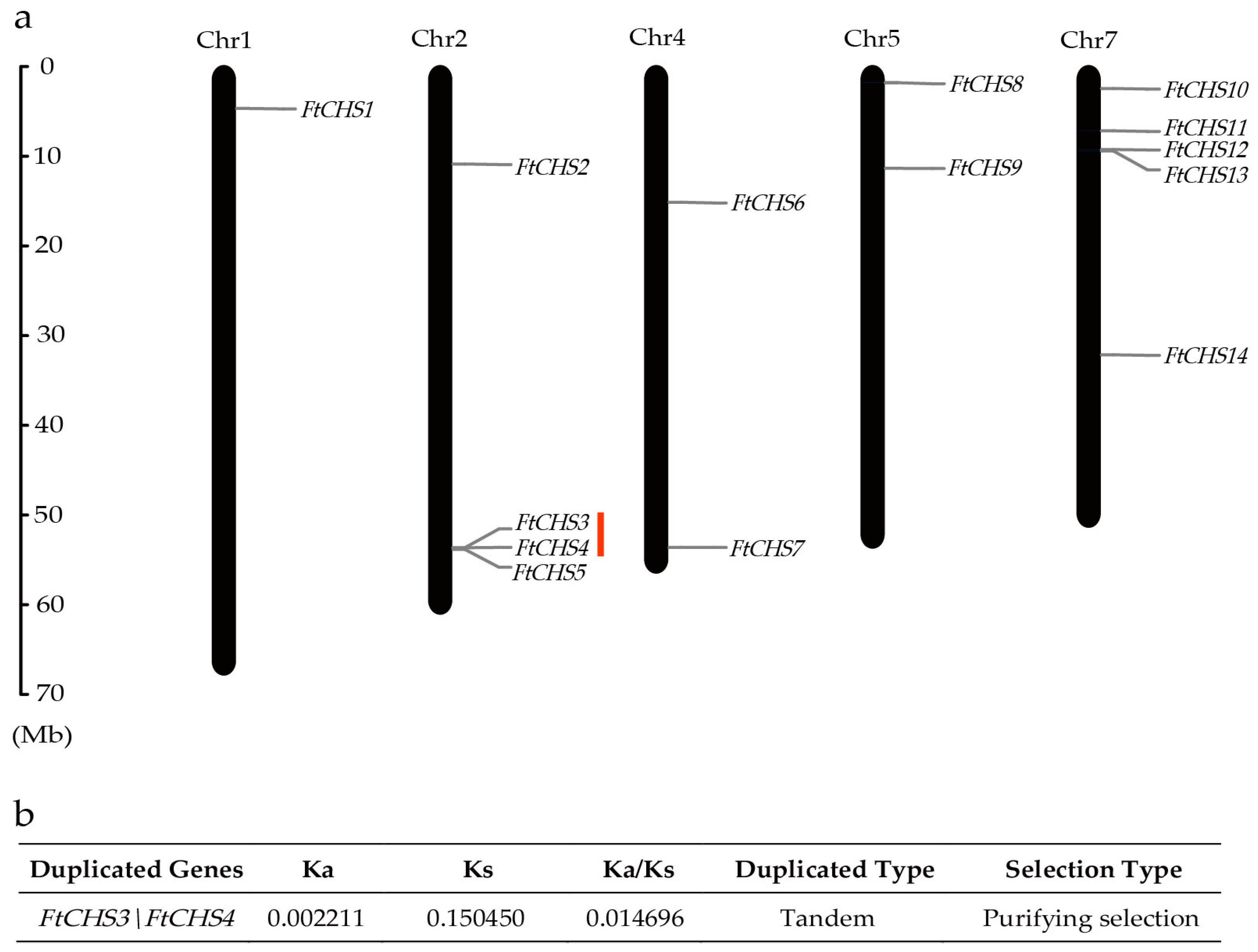

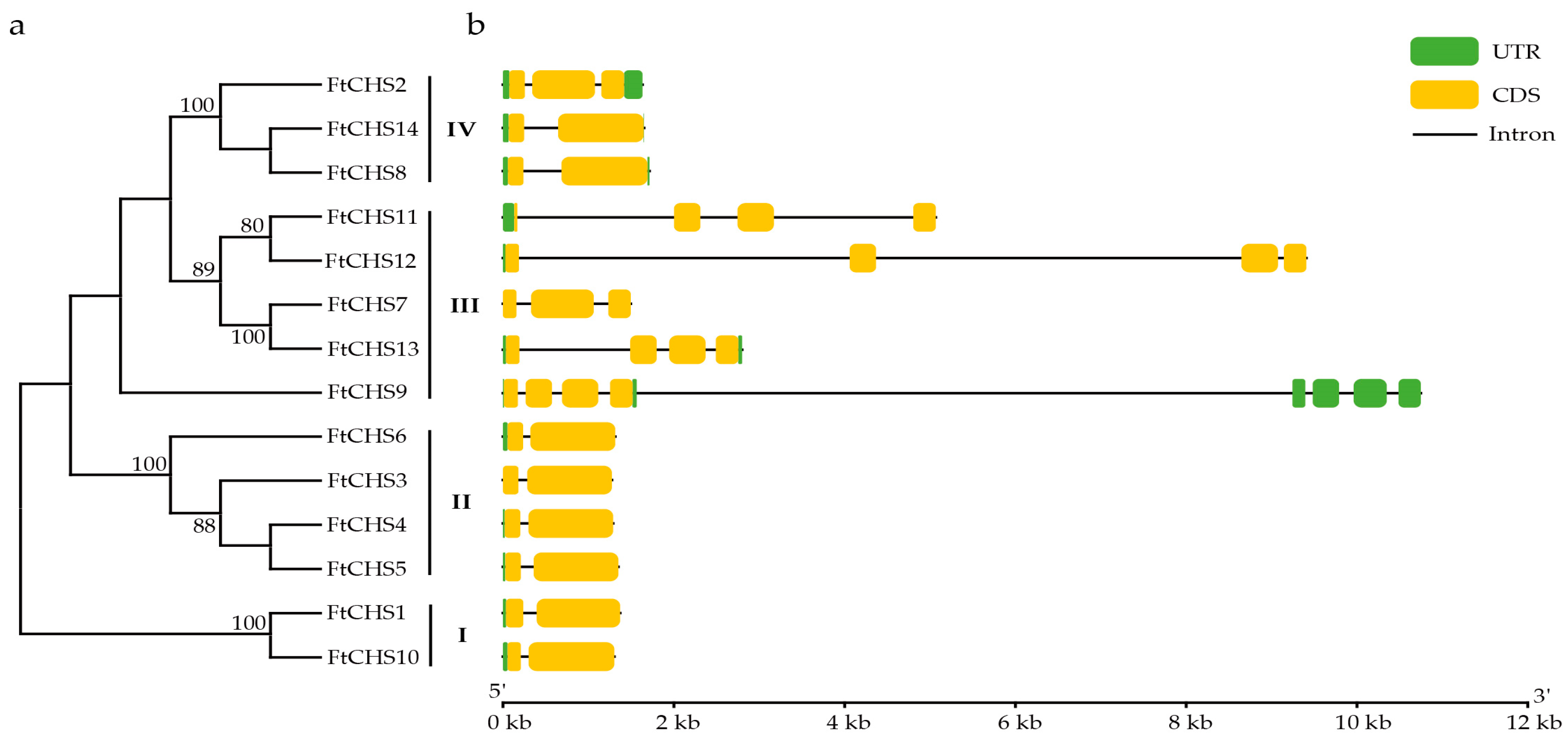

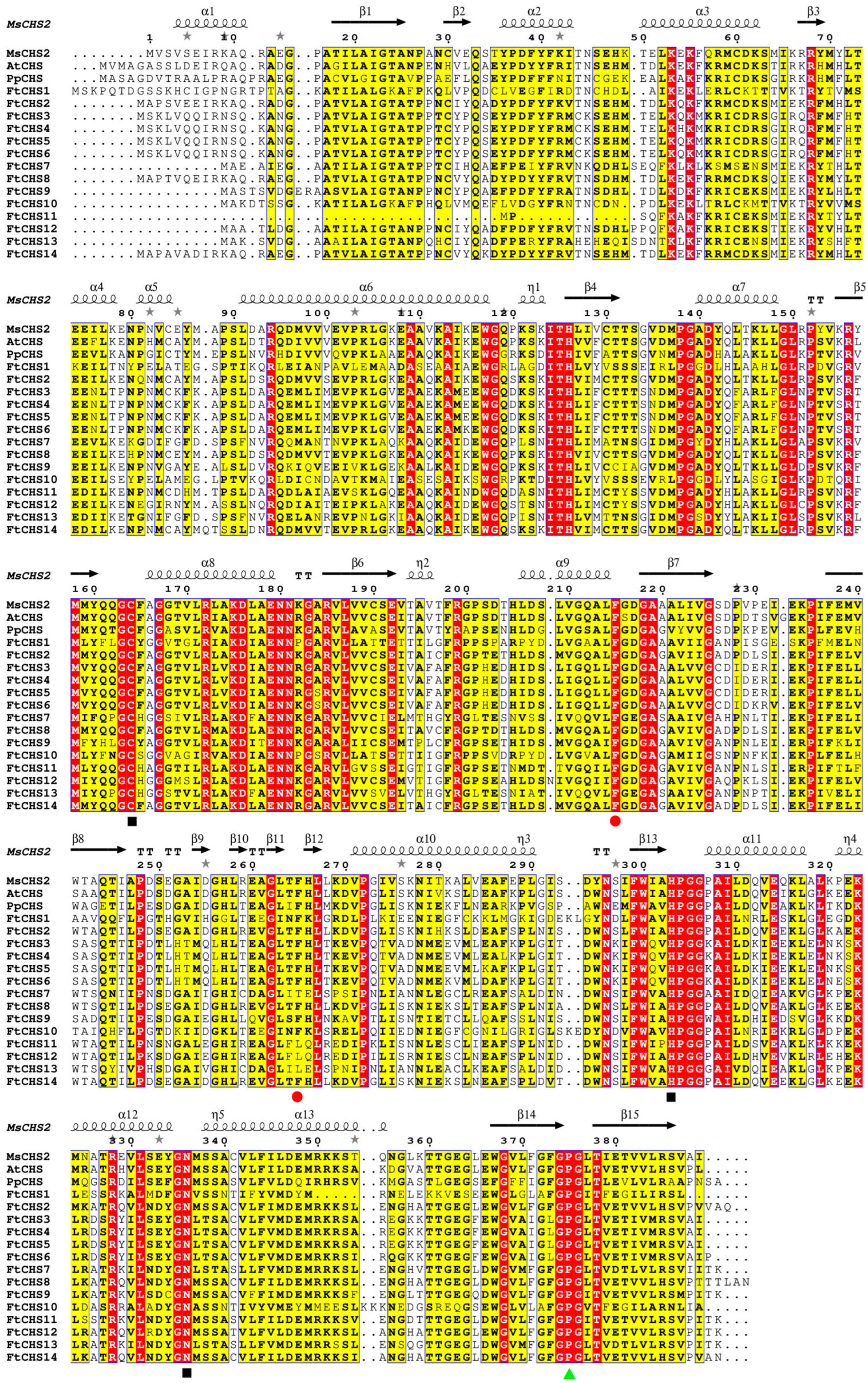
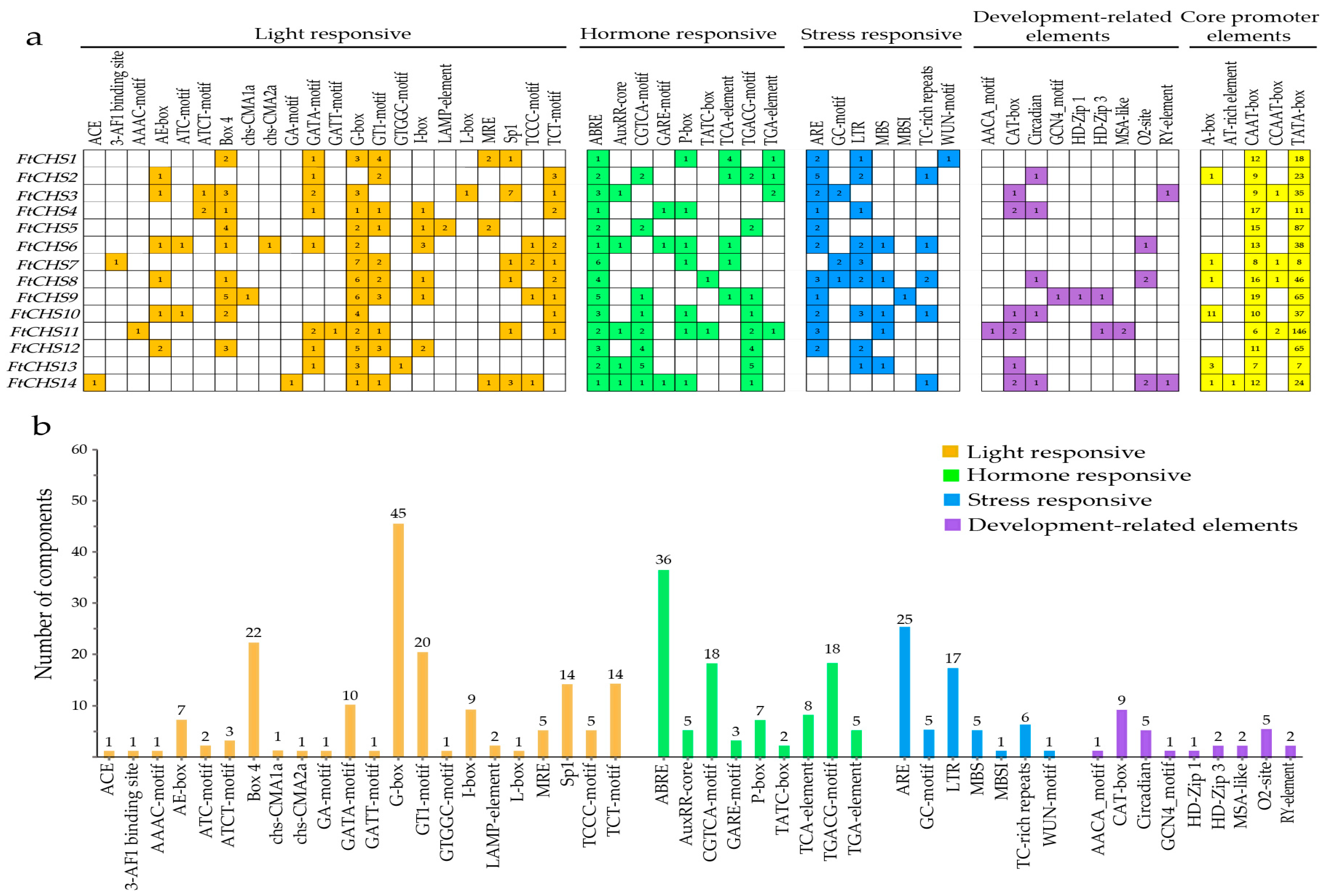
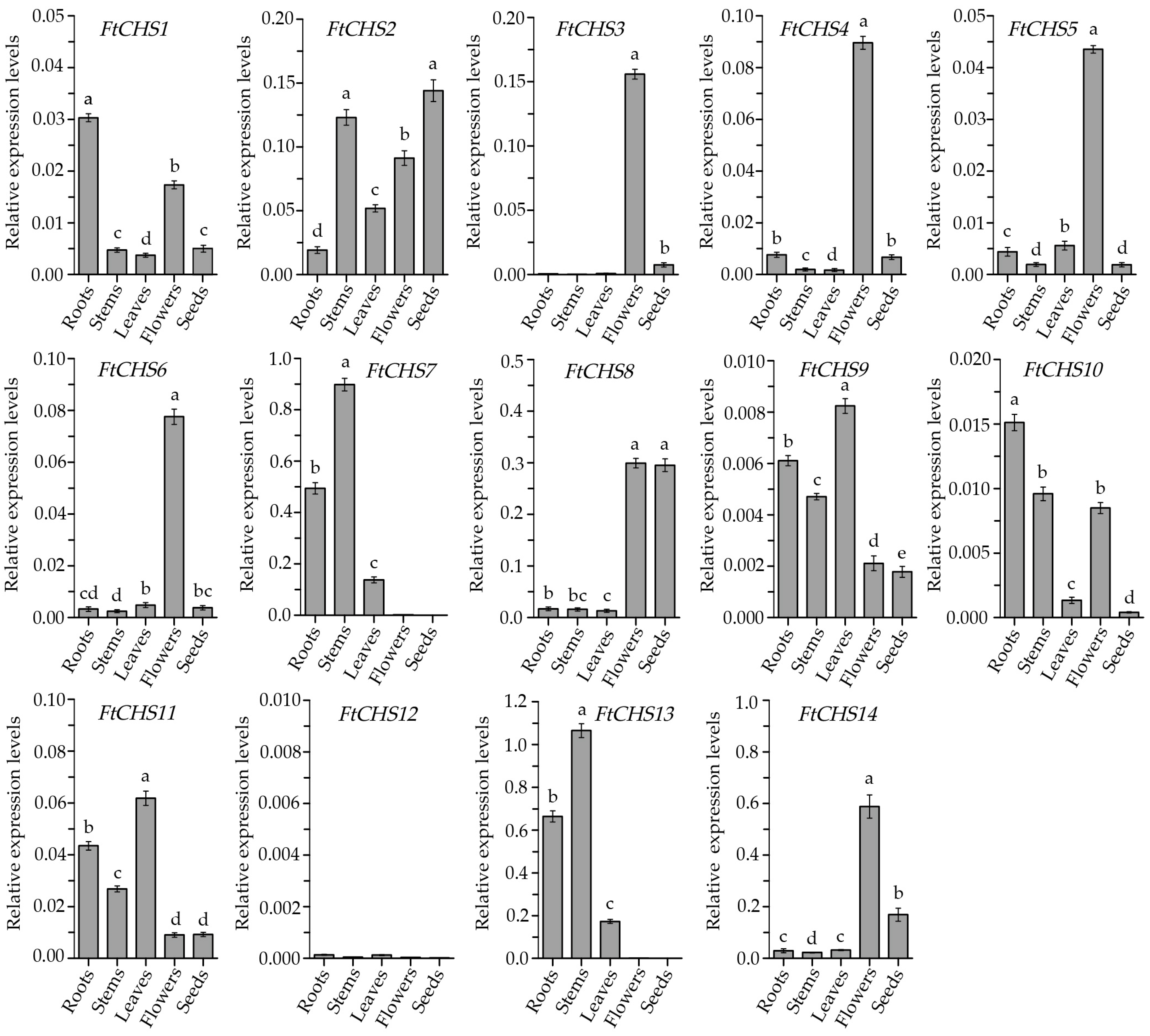
| Gene Name | Gene ID | Chromosomal Position | Open Reading Frame (bp) | Coding Sequence (bp) | Number of Exons |
|---|---|---|---|---|---|
| FtCHS1 | FtPinG0000291700.01 | Chr1: 4,675,628–4,676,999 (+) | 1179 | 1176 | 2 |
| FtCHS2 | FtPinG0008131000.01 | Chr2: 10,868,328–10,869,961 (−) | 1182 | 1179 | 3 |
| FtCHS3 | FtPinG0003701300.01 | Chr2: 53,644,013–53,645,287 (+) | 1173 | 1170 | 2 |
| FtCHS4 | FtPinG0003701500.01 | Chr2: 53,650,904–53,652,193 (+) | 1173 | 1170 | 2 |
| FtCHS5 | FtPinG0003710800.01 | Chr2: 53,836,790–53,838,140 (−) | 1173 | 1170 | 2 |
| FtCHS6 | FtPinG0006832300.01 | Chr4: 15,131,108–15,132,422 (−) | 1176 | 1173 | 2 |
| FtCHS7 | FtPinG0008741700.01 | Chr4: 53,611,525–53,613,020 (+) | 1155 | 1152 | 3 |
| FtCHS8 | FtPinG0000551600.01 | Chr5: 1,802,553–1,804,267 (−) | 1188 | 1185 | 2 |
| FtCHS9 | FtPinG0001351300.01 | Chr5: 11,342,805–11,353,551 (+) | 1161 | 1158 | 8 |
| FtCHS10 | FtPinG0002783200.01 | Chr7: 2,444,081–2,445,384 (−) | 1158 | 1155 | 2 |
| FtCHS11 | FtPinG0009022800.01 | Chr7: 7,164,510–7,169,577 (−) | 1035 | 1032 | 4 |
| FtCHS12 | FtPinG0002110600.01 | Chr7: 9,248,374–9,257,781 (+) | 1158 | 1155 | 4 |
| FtCHS13 | FtPinG0002106500.01 | Chr7: 9,413,803–9,416,602 (−) | 1155 | 1152 | 4 |
| FtCHS14 | FtPinG0008806400.01 | Chr7: 32,140,231–32,141,882 (−) | 1182 | 1179 | 2 |
| Protein Name | Protein Length (aa) | Molecular Weight (Da) | Isoelectric Point | Instability Index | Grand Average of Hydropathicity | Subcellular Localization |
|---|---|---|---|---|---|---|
| FtCHS1 | 392 | 42,274.70 | 5.98 | 37.16 | −0.083 | Cytoplasm |
| FtCHS2 | 393 | 43,177.87 | 5.85 | 40.75 | −0.113 | Cytoplasm |
| FtCHS3 | 390 | 43,646.41 | 6.18 | 37.00 | −0.215 | Cytoplasm |
| FtCHS4 | 390 | 43,621.40 | 6.24 | 37.17 | −0.212 | Cytoplasm |
| FtCHS5 | 390 | 43,661.46 | 6.53 | 37.50 | −0.223 | Cytoplasm |
| FtCHS6 | 391 | 43,728.64 | 7.58 | 36.17 | −0.219 | Cytoplasm |
| FtCHS7 | 384 | 41,933.31 | 5.90 | 36.78 | 0.013 | Cytoplasm |
| FtCHS8 | 395 | 43,438.97 | 5.67 | 37.90 | −0.156 | Cytoplasm |
| FtCHS9 | 386 | 42,299.78 | 5.66 | 35.82 | −0.013 | Cytoplasm |
| FtCHS10 | 385 | 42,210.40 | 5.38 | 36.97 | −0.167 | Cytoplasm |
| FtCHS11 | 344 | 37,702.24 | 5.77 | 40.59 | −0.144 | Cytoplasm |
| FtCHS12 | 385 | 42,398.83 | 6.14 | 46.42 | −0.052 | Cytoplasm |
| FtCHS13 | 384 | 41,904.86 | 5.61 | 33.25 | −0.065 | Cytoplasm |
| FtCHS14 | 393 | 43,208.72 | 5.78 | 36.52 | −0.150 | Cytoplasm |
| Motif | Width (aa) | Best Possible Match Sequence | Domain |
|---|---|---|---|
| 1 | 119 | SLDARQEMAITEVPKLGKEAAZKAIKEWGQPKSKITHLIMCTTSGVDMPGADYQLAKLLGLRPSVKRFMVYQQGCFAGGTVLRLAKDJAENNKGARVLVVCSEITAIGFRGPSETHJDS | Chal−sti−synt_N |
| 2 | 159 | LSIEKPIFELVWTSQTIJPDSEGAIEGHLREAGLTFHLTKDVPQLISNNIEKCLLEAFSPLNITDWNSIFWIAHPGGPAILDQIEEKLGLKKEKLRATRQVLNDYGNMSSACVLFVMDEMRKKSLENGHATTGEGLDWGVLFGFGPGLTVETVVLRSVP | Chal−sti−synt_C |
| 3 | 80 | QZIRKAQKANGPATVLAIGTATPPTCYPQSEYPDFYFRVTKSEHMTELKQKFKRICDKSGIEKRFMFLTEEILTPNPNMC | Chal−sti−synt_N |
| 4 | 21 | LVGQALFGDGAGAVIVGABPB | Chal−sti−synt_N |
| 5 | 39 | QFKEKFKRICEKSMIEKRYTHLTEEILKENPNIAGYDSP | Chal−sti−synt_N |
| 6 | 35 | GAATILAIGTANPPQCIYQADFPDGYFRATNSDHL | Chal−sti−synt_N |
| 7 | 111 | QQFLPGTDGIIDGGLTEEGINFKLGRELPQKIEENIEGFCGKJLGKIGDEKEGYNDLFWAVHPGGPAILNRJEKKLGLEGEKLEASRKALADFGNVSSNTIFYVMEYMREE | Chal−sti−synt_C |
| 8 | 20 | EWGLGLAFGPGITFEGILIR | Chal−sti−synt_C |
| 9 | 6 | TTTLAN | * |
| 10 | 7 | KPFFELN | * |
| 11 | 11 | KKNEDGSREQC | * |
| 12 | 6 | MAKDVD | * |
| 13 | 6 | MAATLD | * |
| 14 | 6 | PNGRTP | * |
| 15 | 6 | KKEEIE | * |
Disclaimer/Publisher’s Note: The statements, opinions and data contained in all publications are solely those of the individual author(s) and contributor(s) and not of MDPI and/or the editor(s). MDPI and/or the editor(s) disclaim responsibility for any injury to people or property resulting from any ideas, methods, instructions or products referred to in the content. |
© 2025 by the authors. Licensee MDPI, Basel, Switzerland. This article is an open access article distributed under the terms and conditions of the Creative Commons Attribution (CC BY) license (https://creativecommons.org/licenses/by/4.0/).
Share and Cite
Wang, Q.; Jia, Y.; Lin, X.; Tan, L.; Du, H.; Wang, A. Identification and Expression Analysis of Chalcone Synthase Gene Family in Tartary Buckwheat. Genes 2025, 16, 451. https://doi.org/10.3390/genes16040451
Wang Q, Jia Y, Lin X, Tan L, Du H, Wang A. Identification and Expression Analysis of Chalcone Synthase Gene Family in Tartary Buckwheat. Genes. 2025; 16(4):451. https://doi.org/10.3390/genes16040451
Chicago/Turabian StyleWang, Qinghai, Yanhua Jia, Xin Lin, Lu Tan, Hanmei Du, and Anhu Wang. 2025. "Identification and Expression Analysis of Chalcone Synthase Gene Family in Tartary Buckwheat" Genes 16, no. 4: 451. https://doi.org/10.3390/genes16040451
APA StyleWang, Q., Jia, Y., Lin, X., Tan, L., Du, H., & Wang, A. (2025). Identification and Expression Analysis of Chalcone Synthase Gene Family in Tartary Buckwheat. Genes, 16(4), 451. https://doi.org/10.3390/genes16040451






